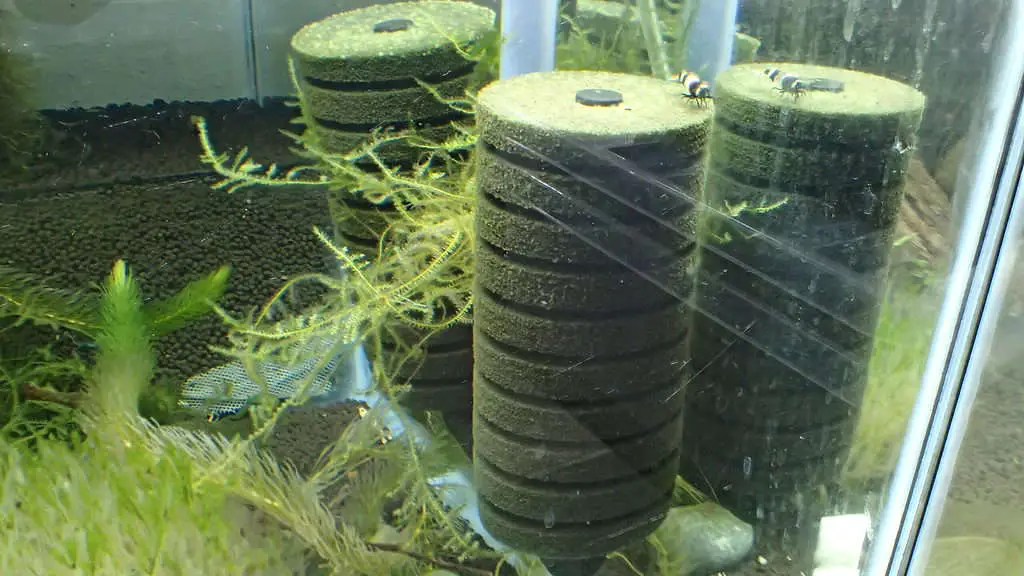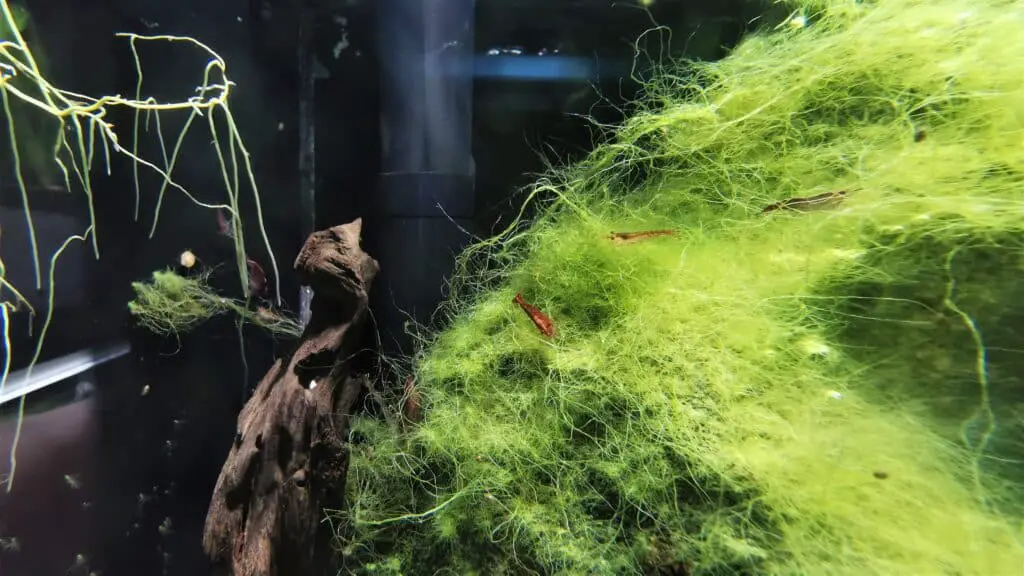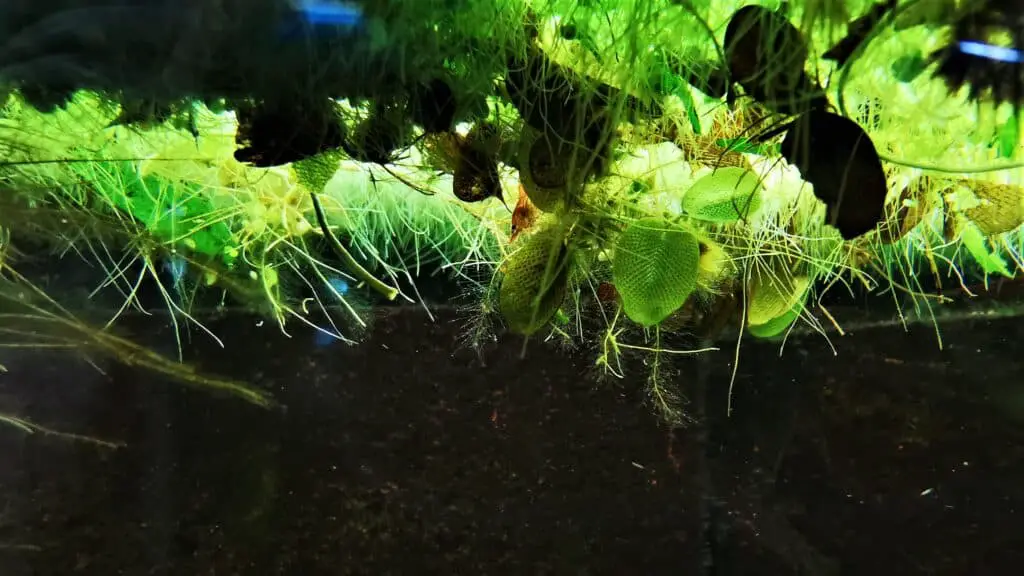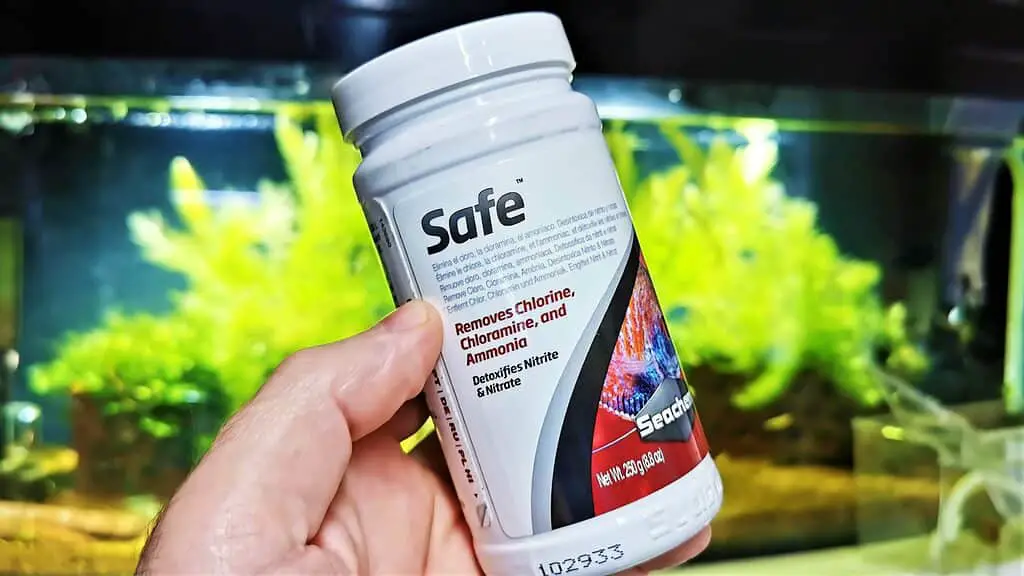As an avid aquarium enthusiast for over a decade, I’ve had the pleasure of creating and maintaining numerous aquatic habitats. One of my favorite experiences has been setting up a tank for cherry shrimp , a vibrant and lively species that adds a splash of color to any aquarium. Over the years, I’ve learned through trial and error what works best for these fascinating creatures.
, a vibrant and lively species that adds a splash of color to any aquarium. Over the years, I’ve learned through trial and error what works best for these fascinating creatures.
In my early days, I remember how my first cherry shrimp tank was a simple setup with just a few plants and a basic filter. Over time, I realized the importance of creating a more natural and thriving ecosystem for these shrimp. I experimented with different elements, from introducing large snails as symbiotic partners to incorporating natural debris like cholla wood and driftwood.
and a basic filter. Over time, I realized the importance of creating a more natural and thriving ecosystem for these shrimp. I experimented with different elements, from introducing large snails as symbiotic partners to incorporating natural debris like cholla wood and driftwood.
In this post, I’m excited to share with you in reverse order my top 5 must-have items for a cherry shrimp tank. These are the result of years of experience and countless hours spent observing and caring for my cherry shrimp. I’ll start with the fifth most important item and work my way up to the most crucial one. Whether you’re a seasoned aquarist or a beginner, I hope these insights will help you create a beautiful and healthy habitat for your cherry shrimp.

6. Using Powdered Goldfish Flakes
One of the lesser-known secrets to stimulating mass breeding of Neocaridina is the use of powdered goldfish flakes. This might come as a surprise to many, but in my experience, it has proven to be incredibly effective.
Goldfish flakes are a rich source of proteins and vitamins, providing the essential nutrients that shrimp need for healthy growth and reproduction. When these flakes are powdered and added to the tank, they disperse throughout the water, making them easily accessible to the shrimp. This not only ensures that all the shrimp in the tank get their share of food, but also stimulates their breeding behavior.
In the tanks where I’ve used this method, I’ve been able to breed thousands of shrimp. It’s a simple and cost-effective strategy that can significantly boost your shrimp population. However, it’s important to use this method judiciously. Overfeeding can lead to poor water quality, so start with small amounts and adjust as needed based on the size of your shrimp population.
Remember, the key to successful shrimp keeping is balance. While it’s exciting to see your shrimp population grow, it’s equally important to maintain a healthy and sustainable environment for them. Always monitor your water parameters and adjust your feeding and maintenance routines as necessary.
5. Symbiotic Partner – Large Snails or Small Plecos
If you’re looking to breed cherry shrimp, it’s important to create a thriving ecosystem in your tank. One way to do this is to add a symbiotic partner that can help clean up organic waste and produce nutrients that the shrimp can feed on. While there are many species of fish and invertebrates that can coexist with cherry shrimp , large snails and small plecos are some of the most popular choices.
, large snails and small plecos are some of the most popular choices.
Large snails, such as Nerite snails or Mystery snails, can be an excellent addition to a cherry shrimp tank. Not only do they help to clean up organic waste, but they also provide a food source for the shrimp
snails or Mystery snails, can be an excellent addition to a cherry shrimp tank. Not only do they help to clean up organic waste, but they also provide a food source for the shrimp . However, it’s important to note that some snails can also eat plants, so it’s important to choose a species that won’t damage the live plants in your tank. Additionally, the shrimp will directly consume the snail’s poop, which can provide another source of nutrients for them.
. However, it’s important to note that some snails can also eat plants, so it’s important to choose a species that won’t damage the live plants in your tank. Additionally, the shrimp will directly consume the snail’s poop, which can provide another source of nutrients for them.
Small plecos, such as the Bristlenose or Clown pleco, are another great option for a symbiotic partner in a cherry shrimp tank. These small fish are excellent at cleaning up algae and other debris, and they also produce a lot of waste, which can be beneficial for the shrimp. Like snails, however, it’s important to choose a species that won’t damage live plants, and to make sure the plecos won’t grow too large for your tank.
When introducing a symbiotic partner to your cherry shrimp tank, it’s important to do so slowly and carefully. This will help to prevent any disruption to the ecosystem and ensure that the shrimp remain healthy and safe. Additionally, it’s important to make sure the tank is large enough to support the additional inhabitants and that water parameters are suitable for all species.

4. Sponge Filter
Sponge filters are an essential piece of equipment for any cherry shrimp tank, as they provide gentle filtration that won’t harm the delicate shrimp. Unlike traditional filters, which can create strong currents and disrupt the shrimp’s environment, sponge filter s offer a slow and steady flow of water that won’t harm the shrimp. Additionally, sponge filter
s offer a slow and steady flow of water that won’t harm the shrimp. Additionally, sponge filter s provide a surface area for beneficial bacteria to grow, which helps to maintain a healthy ecosystem in the tank.
s provide a surface area for beneficial bacteria to grow, which helps to maintain a healthy ecosystem in the tank.
One of the benefits of using a sponge filter is that waste can accumulate in the sponge, which the shrimp can then graze on. As the shrimp feed on the waste, they help to keep the tank clean, which can reduce the amount of maintenance required. Additionally, sponge filters are relatively easy to clean and maintain. Simply rinse the sponge in old aquarium water, rather than tap water, to avoid killing the beneficial bacteria.
is that waste can accumulate in the sponge, which the shrimp can then graze on. As the shrimp feed on the waste, they help to keep the tank clean, which can reduce the amount of maintenance required. Additionally, sponge filters are relatively easy to clean and maintain. Simply rinse the sponge in old aquarium water, rather than tap water, to avoid killing the beneficial bacteria.
When choosing a sponge filter for your cherry shrimp tank, it’s important to choose one that is appropriately sized for your tank. A filter that is too small won’t provide enough filtration, while a filter that is too large can create too strong of a flow and disrupt the shrimp’s environment. Additionally, it’s important to keep an eye on the sponge filter and clean it regularly, as a dirty sponge can lead to poor water quality and harm the shrimp.
tank, it’s important to choose one that is appropriately sized for your tank. A filter that is too small won’t provide enough filtration, while a filter that is too large can create too strong of a flow and disrupt the shrimp’s environment. Additionally, it’s important to keep an eye on the sponge filter and clean it regularly, as a dirty sponge can lead to poor water quality and harm the shrimp.

 on the left
on the left3. Natural Debris – Cholla Wood, Driftwood, Leaves, etc.
Adding natural debris to a cherry shrimp tank is an excellent way to create a natural environment that supports the shrimp’s health and well-being. Natural debris such as cholla wood, driftwood, and leaves can provide hiding spots for the shrimp, as well as a surface for beneficial bacteria and biofilm to grow on. Additionally, natural debris can provide a source of nutrients for the shrimp, as they will graze on the biofilm and the decaying leaves.
There are many different types of natural debris that are suitable for a cherry shrimp tank, including aquatic woods like cholla wood and driftwood, as well as leaves such as bamboo leaves, almond leaves, and walnut leaves. When selecting natural debris, it’s important to make sure that it’s safe for aquarium use and that it hasn’t been treated with any chemicals or pesticides. Additionally, some natural debris can release tannins into the water, which can lower the pH of the tank. While this can be beneficial for some species, it’s important to monitor the water parameters and make adjustments if necessary.
Before adding natural debris to the tank, it’s a good idea to soak the items in water overnight to help remove any excess tannins or debris. This can help to prevent cloudiness in the water and keep the tank looking clean and clear. Additionally, it’s important to make sure that the natural debris is appropriately sized for the tank and that it doesn’t create any sharp edges or potential hazards for the shrimp.

2. Live Plants
Live plants are an important component of any successful cherry shrimp tank. Not only do they help to oxygenate the water and provide a natural environment for the shrimp, but they also help to remove excess nutrients and maintain water quality. Additionally, live plants can provide a food source for the shrimp, as they will feed on decaying plant matter and the microorganisms that grow on the plants.
One of the most popular types of live plants for cherry shrimp tanks is moss. Moss, such as Java Moss or Christmas Moss, is easy to care for and provides a natural and lush environment for the shrimp to hide and feed. Additionally, moss can provide a surface for beneficial bacteria and biofilm to grow on, which helps to maintain water quality in the tank.
Other popular live plants for cherry shrimp tanks include Anubias, Cryptocoryne, and Java Fern . These plants are relatively low-maintenance and can tolerate a wide range of water conditions. Additionally, they can provide a natural and aesthetic appeal to the tank, which can enhance the overall experience of owning cherry shrimp.
. These plants are relatively low-maintenance and can tolerate a wide range of water conditions. Additionally, they can provide a natural and aesthetic appeal to the tank, which can enhance the overall experience of owning cherry shrimp.
Make your plants safe with Alum dip
1. Dechlorinator
Dechlorinator is the number one must-have item for any cherry shrimp tank, as it ensures the safety and well-being of the shrimp. When tap water is treated with chlorine or chloramines, it can be harmful to the delicate balance of the aquarium ecosystem, and even deadly for the shrimp. Dechlorinator is designed to neutralize these chemicals, making the water safe for the shrimp to live in.
There are many different brands of dechlorinator available on the market, but some popular choices include Seachem Prime/Safe, API Tap Water Conditioner, and Tetra AquaSafe Plus. When selecting a dechlorinator, it’s important to choose one that is safe for aquarium use and appropriate for the size of your tank. Additionally, make sure to follow the instructions carefully, as using too much or too little can harm the shrimp.
There are many reasons why you should use dechlorinator in your cherry shrimp tank. First and foremost, it ensures the safety and well-being of the shrimp, by removing harmful chemicals from the tap water. Additionally, dechlorinator can help to reduce stress in the shrimp, which can enhance their overall health and vitality. Finally, dechlorinator can help to maintain water quality in the tank, which is essential for a healthy ecosystem.
The Most Comprehensive Guide To Cherry Shrimp
Conclusion
Creating a thriving environment for cherry shrimp involves a thoughtful selection of symbiotic partners, a suitable sponge filter, natural debris, live plants, and a reliable dechlorinator. Each of these elements plays a crucial role in maintaining a healthy and natural ecosystem for your cherry shrimp. Remember, the key is to prioritize the needs of your shrimp and create a habitat that promotes their well-being. If you need any help or have any questions, please don’t hesitate to reach out. Happy Shrimp Keeping!
FAQ Section
Q: What are cherry shrimp? A: Cherry shrimp are a popular species of freshwater shrimp that are commonly kept in aquariums. They are named for their bright red color, which resembles a cherry.
Q: What is the scientific name of cherry shrimp? A: The scientific name of cherry shrimp is Neocaridina davidi var. red.
var. red.
Q: What size do cherry shrimp typically grow to? A: Cherry shrimp typically grow to be around 1-1.5 inches in length.
Q: What is the ideal water temperature for cherry shrimp ? A: The ideal water temperature for cherry shrimp is between 70-80 degrees Fahrenheit.
? A: The ideal water temperature for cherry shrimp is between 70-80 degrees Fahrenheit.
Q: What is the ideal pH level for cherry shrimp? A: The ideal pH level for cherry shrimp is between 6.5-7.5.
Q: What do cherry shrimp eat ? A: Cherry shrimp are omnivorous and will eat a variety of foods, including algae, biofilm, small insects, and commercial shrimp pellets.
? A: Cherry shrimp are omnivorous and will eat a variety of foods, including algae, biofilm, small insects, and commercial shrimp pellets.
Q: How do I care for cherry shrimp in an aquarium? A: Cherry shrimp require a stable and clean environment with adequate hiding places and a source of food. They can be kept in a variety of aquarium setups, including planted tanks and shrimp-only tanks. It is important to maintain proper water parameters and perform regular water changes to ensure their health.
Q: Can cherry shrimp live with other fish? A: Cherry shrimp can be kept with other peaceful fish species that will not prey on them. It is important to avoid keeping them with larger or more aggressive fish that may harm or eat them.
Q: How often should I feed my cherry shrimp ? A: Cherry shrimp should be fed small amounts of food multiple times a day. It is important not to overfeed them, as excess food can lead to poor water quality and health issues.
? A: Cherry shrimp should be fed small amounts of food multiple times a day. It is important not to overfeed them, as excess food can lead to poor water quality and health issues.
Q: Can cherry shrimp breed in an aquarium? A: Yes, cherry shrimp are known for their prolific breeding habits and can breed readily in an aquarium with suitable conditions. Females can carry hundreds of eggs, which will hatch into tiny shrimp larvae.
Q: How long do cherry shrimp typically live? A: Cherry shrimp have a lifespan of around 1-2 years, although this can vary depending on factors such as water quality, diet, and genetics.


